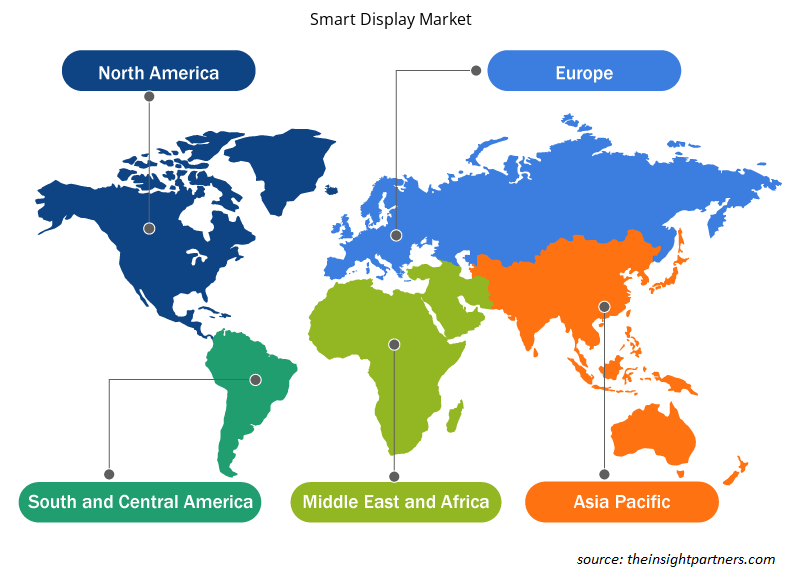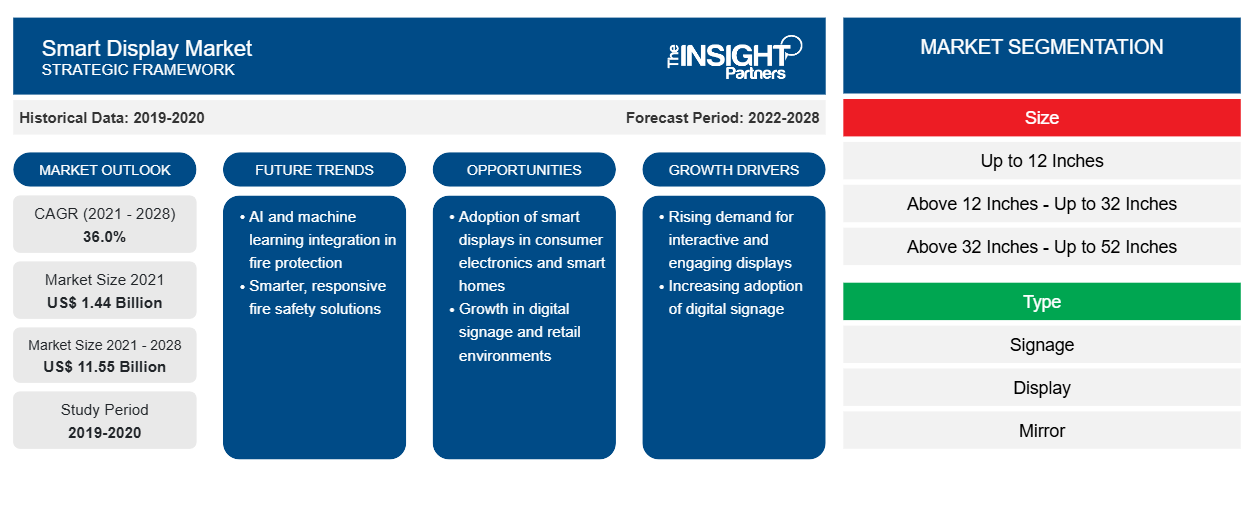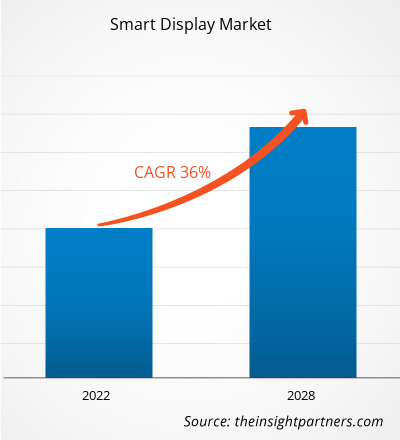Der Markt für intelligente Displays wurde im Jahr 2021 auf 1.443,74 Millionen US-Dollar geschätzt und soll bis 2028 11.547,23 Millionen US-Dollar erreichen; von 2022 bis 2028 wird eine durchschnittliche jährliche Wachstumsrate (CAGR) von 36,0 % erwartet.
Ein Smart Display ist ein digitales Display, das über Sprachfernbedienungen oder mit dem Internet der Dinge (IoT) verbundene Geräte bedient werden kann. Ein Smart Mirror beispielsweise ist ein innovatives Gerät, das die persönlichen Daten der Benutzer und die Erfahrungen der Käufer im Automobil- und Einzelhandelssektor aufzeichnet. Darüber hinaus verfügt das Smart Display als hochmoderne technische Lösung über interaktive und komplexe Steuerungsfunktionen.
Die wichtigsten Antriebsfaktoren für das Wachstum des Marktes für intelligente Displays sind die hohe Nachfrage der Automobilindustrie nach intelligenten Spiegeln , neue und innovative Funktionen, die intelligente Spiegel bieten, eine steigende Zahl von Internetnutzern und eine zunehmende Nutzung intelligenter Geräte entsprechend den Vorlieben der Verbraucher, eine steigende Nachfrage nach KI- und IoT-fähigen intelligenten Haushaltsgeräten, ein zunehmender Trend zu kontextsensitiver Beschilderung und die zunehmende Nutzung intelligenter Beschilderung im Einzelhandel.
Der wachsende Einzelhandel wird durch die steigende Kaufkraft der Verbraucher unterstützt. Außerdem treiben schnell wachsende Einkaufszentren und Einzelhandelsflächen weltweit die Nachfrage nach intelligenten Beschilderungslösungen voran, um Passanten anzuziehen und sie zum Betreten des Geschäfts zu ermutigen. Daher sind die Smart Stores daran interessiert, Programmatic Advertising zu nutzen, um die Markenbekanntheit zu steigern. Smart Signage kann auch als Teil des Zahlungsvorgangs verwendet werden. Kunden können mit einem Mobilgerät bezahlen, anstatt in einer Warteschlange an der Kasse zu stehen. Mehrere Einzelhändler wie Walmart, Alibaba, Amazon und Carrefour haben weltweit Smart Stores eingerichtet. Sie verwenden in den Smart Stores verschiedene intelligente Einzelhandelslösungen und -technologien wie Smart Signage. Einzelhändler weltweit haben Expansions- und Partnerschaftsstrategien umgesetzt, um intelligentere und kassenlose Geschäfte zu eröffnen. All diese Faktoren steigern die Größe des Marktes für intelligente Displays .
Passen Sie diesen Bericht Ihren Anforderungen an
Sie erhalten kostenlose Anpassungen an jedem Bericht, einschließlich Teilen dieses Berichts oder einer Analyse auf Länderebene, eines Excel-Datenpakets sowie tolle Angebote und Rabatte für Start-ups und Universitäten.
- Holen Sie sich die wichtigsten Markttrends aus diesem Bericht.Dieses KOSTENLOSE Beispiel umfasst eine Datenanalyse von Markttrends bis hin zu Schätzungen und Prognosen.
Einblicke in den Smart Display-Markt
Präsenz beliebter Marken
Sobald sich die Kunden an das Produkt einer bestimmten Marke gewöhnt haben, kaufen sie weitere Produkte derselben Marke. Einige bekannte Marken wie Google, Amazon, Inc., Bosch, Panasonic, BenQ Corporation, LG Electronics, Lenovo Group, Ltd., Samsung Corporation und Sony Corporation bieten verschiedene Smart-Display-Lösungen für die Automobil-, Gesundheits-, Wohn- und Einzelhandelsbranche an. Diese Marken ziehen mühelos ihre treuen Kunden an und sind ein wichtiger Wachstumsfaktor für den Smart-Display-Markt. Marken bewerben ihre Produkte manchmal vor der Markteinführung, um bei den Kunden einen Hype zu erzeugen. So wurde beispielsweise im März 2022 das Smart Display 10 von Xiaomi auf mehreren Websites aufgeführt und das Produkt wurde im April 2022 auf den Markt gebracht. Im Januar 2022 brachte Google sein Smart Display Google Nest Hub der 2. Generation in Indien für 103,24 US-Dollar auf den Markt. Im Juni 2021 brachte Amazon zwei neue Smart-Display-Produkte auf den indischen Markt: den Echo Show 10 und 5. Die steigende Popularität der Marken treibt also das Wachstum des Smart-Display-Marktes voran.
Größenbasierte Markteinblicke
Basierend auf der Größe ist der Markt für Smart Displays in bis zu 12 Zoll, über 12 Zoll – bis zu 32 Zoll, über 32 Zoll – bis zu 52 Zoll und über 52 Zoll unterteilt. Die Bildschirmgrößen variieren von Hersteller zu Hersteller. Während einige Hersteller auch bei kleineren Bildschirmgrößen eine höhere Funktionalität bieten, ziehen es andere vor, die Funktionalität je nach Bildschirmgröße zu variieren. Der Markt wird hauptsächlich durch die wachsende Nachfrage nach mittelgroßen Smart Signage-Displays in verschiedenen Branchen weltweit angetrieben.
Lösungsbasierte Markteinblicke
Basierend auf der Auflösung ist der Markt für Smart Displays in Full High Definition (FHD), Ultra High Definition (UHD) und andere unterteilt. Smart Displays mit HD-Auflösung werden hauptsächlich für Wohnanwendungen verwendet. Die meisten anderen Anwendungen, wie z. B. Werbeschilder oder Smart Kioske, verwenden jedoch zunehmend Displays mit UHD- und FHD-Auflösung. Der Markt wird hauptsächlich durch die wachsende Nachfrage nach Smart Signage-Displays mit besserer Auflösung angetrieben, damit die Benutzer ein immersives Erlebnis genießen können.
Die Akteure auf dem Markt für intelligente Displays verfolgen Strategien wie Fusionen, Übernahmen und Marktinitiativen, um ihre Position auf dem Markt zu behaupten. Nachfolgend sind einige Entwicklungen der wichtigsten Marktteilnehmer aufgeführt:
- Laut NoviSign, einem Branchenführer und Pionier im Bereich Android Digital Signage, ist die NoviSign Android Digital Signage App derzeit für alle Sony BRAVIA Professional Android-basierten Displays verfügbar. Die professionelle BRAVIA-Reihe von Sony unterstützt 4K und HDR, verfügt über eine System-on-a-Chip-Plattform und ist in Größen von 32 bis 100 Zoll erhältlich.
- BenQ, ein führender Anbieter interaktiver Displaytechnologien, hat sich der Integrated Solutions Initiative for Education von Google angeschlossen. Mit der Teilnahme an dieser Initiative unterstreicht BenQ sein Engagement, Bildungslösungen bereitzustellen, die es Schulen ermöglichen, widerstandsfähigere aktive Lernumgebungen zu schaffen, die für Präsenz- und Fernunterricht geeignet sind.
Regionale Einblicke in den Smart Display-Markt
Die regionalen Trends und Faktoren, die den Smart Display-Markt im Prognosezeitraum beeinflussen, wurden von den Analysten von Insight Partners ausführlich erläutert. In diesem Abschnitt werden auch die Marktsegmente und die Geografie des Smart Display-Marktes in Nordamerika, Europa, im asiatisch-pazifischen Raum, im Nahen Osten und Afrika sowie in Süd- und Mittelamerika erörtert.

- Erhalten Sie regionale Daten zum Smart Display-Markt
Umfang des Marktberichts für intelligente Displays
| Berichtsattribut | Details |
|---|---|
| Marktgröße im Jahr 2021 | 1,44 Milliarden US-Dollar |
| Marktgröße bis 2028 | 11,55 Milliarden US-Dollar |
| Globale CAGR (2021 - 2028) | 36,0 % |
| Historische Daten | 2019-2020 |
| Prognosezeitraum | 2022–2028 |
| Abgedeckte Segmente | Nach Größe
|
| Abgedeckte Regionen und Länder | Nordamerika
|
| Marktführer und wichtige Unternehmensprofile |
|
Marktteilnehmerdichte: Der Einfluss auf die Geschäftsdynamik
Der Markt für Smart Displays wächst rasant, angetrieben durch die steigende Nachfrage der Endnutzer aufgrund von Faktoren wie sich entwickelnden Verbraucherpräferenzen, technologischen Fortschritten und einem größeren Bewusstsein für die Vorteile des Produkts. Mit steigender Nachfrage erweitern Unternehmen ihr Angebot, entwickeln Innovationen, um die Bedürfnisse der Verbraucher zu erfüllen, und nutzen neue Trends, was das Marktwachstum weiter ankurbelt.
Die Marktteilnehmerdichte bezieht sich auf die Verteilung der Firmen oder Unternehmen, die in einem bestimmten Markt oder einer bestimmten Branche tätig sind. Sie gibt an, wie viele Wettbewerber (Marktteilnehmer) in einem bestimmten Marktraum im Verhältnis zu seiner Größe oder seinem gesamten Marktwert präsent sind.
Die wichtigsten auf dem Smart Display-Markt tätigen Unternehmen sind:
- Alphabet Inc.
- Amazon.com, Inc.
- LG Electronics
- LENOVO GROUP LIMITED
- Magna International Inc
Haftungsausschluss : Die oben aufgeführten Unternehmen sind nicht in einer bestimmten Reihenfolge aufgeführt.

- Überblick über die wichtigsten Akteure auf dem Smart Display-Markt
Der globale Markt für Smart Displays ist nach Größe, Typ, Auflösung und Branche segmentiert. Nach Größe ist der Markt in bis zu 12 Zoll, über 12 Zoll – bis zu 32 Zoll, über 32 Zoll – bis zu 52 Zoll und über 52 Zoll segmentiert. Nach Typ ist der Markt in Beschilderung, Display und Spiegel segmentiert. Nach Auflösung ist der Markt in Full High Definition, Ultra High Definition und andere segmentiert. Darüber hinaus ist der Markt für Smart Displays nach Branche in Verbraucher- und Haushaltsgeräte, Automobil, Einzelhandel, Gesundheitswesen und andere segmentiert.
Alphabet Inc.; Amazon.com, Inc.; LG Electronics; LENOVO GROUP LIMITED; Magna International Inc; Panasonic Corporation; Sony Corporation; BenQ Corporation; NEXCOM International Co., Ltd.; und Samsung Electronics Co., Ltd. sind die wichtigsten Akteure auf dem Markt für Smart Displays, die für die Forschungsstudie berücksichtigt wurden. Darüber hinaus wurden in diesem Forschungsbericht mehrere andere bedeutende Marktteilnehmer untersucht und analysiert, um einen ganzheitlichen Überblick über den globalen Markt für Smart Displays und sein Ökosystem zu erhalten.
- Historische Analyse (2 Jahre), Basisjahr, Prognose (7 Jahre) mit CAGR
- PEST- und SWOT-Analyse
- Marktgröße Wert/Volumen – Global, Regional, Land
- Branche und Wettbewerbsumfeld
- Excel-Datensatz


- Vaginal Specula Market
- UV Curing System Market
- Flexible Garden Hoses Market
- Nuclear Waste Management System Market
- Artificial Intelligence in Defense Market
- Intraoperative Neuromonitoring Market
- Dealer Management System Market
- Cosmetic Bioactive Ingredients Market
- Hot Melt Adhesives Market
- Molecular Diagnostics Market

Report Coverage
Revenue forecast, Company Analysis, Industry landscape, Growth factors, and Trends

Segment Covered
This text is related
to segments covered.

Regional Scope
North America, Europe, Asia Pacific, Middle East & Africa, South & Central America

Country Scope
This text is related
to country scope.
Häufig gestellte Fragen
The adoption of smart signage enables a variety of content to be displayed and scheduled multiple times in a day or week. The context-aware smart signage provides active and real-time information. For instance, it can provide information related to weather; during the rainy season, it can show advertisements for umbrellas, or in summer, it can display advertisements for sunglasses.
The countries that registered a high growth rate during the forecast period are United States, Germany, UK, China, India, and South Korea
Based on type, the smart display market is segmented into display, mirror, and signage. The display segment mostly consists of smart display devices, such as Amazon’s Echo Show and Google’s Nest Max, and automotive smart displays. The growing penetration of IoT and the increasing adoption of smart home products drive market growth.
The top five key players operating in the global smart display market include Amazon, Baidu, Google, Alibaba, and Apple in 2021.
The global market size for smart display market in 2021 is estimated to be $ 1443.74 million.
The driving factors that influence the global smart display market are technological advancements and presence of popular brands.
Trends and growth analysis reports related to Electronics and Semiconductor : READ MORE..
The List of Companies - Smart Display Market
- Alphabet Inc.
- Amazon.com, Inc.
- LG Electronics
- LENOVO GROUP LIMITED
- Magna International Inc
- Panasonic Corporation
- Sony Corporation
- BenQ Corporation
- NEXCOM International Co., Ltd.
- Samsung Electronics Co., Ltd.
The Insight Partners performs research in 4 major stages: Data Collection & Secondary Research, Primary Research, Data Analysis and Data Triangulation & Final Review.
- Data Collection and Secondary Research:
As a market research and consulting firm operating from a decade, we have published and advised several client across the globe. First step for any study will start with an assessment of currently available data and insights from existing reports. Further, historical and current market information is collected from Investor Presentations, Annual Reports, SEC Filings, etc., and other information related to company’s performance and market positioning are gathered from Paid Databases (Factiva, Hoovers, and Reuters) and various other publications available in public domain.
Several associations trade associates, technical forums, institutes, societies and organization are accessed to gain technical as well as market related insights through their publications such as research papers, blogs and press releases related to the studies are referred to get cues about the market. Further, white papers, journals, magazines, and other news articles published in last 3 years are scrutinized and analyzed to understand the current market trends.
- Primary Research:
The primarily interview analysis comprise of data obtained from industry participants interview and answers to survey questions gathered by in-house primary team.
For primary research, interviews are conducted with industry experts/CEOs/Marketing Managers/VPs/Subject Matter Experts from both demand and supply side to get a 360-degree view of the market. The primary team conducts several interviews based on the complexity of the markets to understand the various market trends and dynamics which makes research more credible and precise.
A typical research interview fulfils the following functions:
- Provides first-hand information on the market size, market trends, growth trends, competitive landscape, and outlook
- Validates and strengthens in-house secondary research findings
- Develops the analysis team’s expertise and market understanding
Primary research involves email interactions and telephone interviews for each market, category, segment, and sub-segment across geographies. The participants who typically take part in such a process include, but are not limited to:
- Industry participants: VPs, business development managers, market intelligence managers and national sales managers
- Outside experts: Valuation experts, research analysts and key opinion leaders specializing in the electronics and semiconductor industry.
Below is the breakup of our primary respondents by company, designation, and region:

Once we receive the confirmation from primary research sources or primary respondents, we finalize the base year market estimation and forecast the data as per the macroeconomic and microeconomic factors assessed during data collection.
- Data Analysis:
Once data is validated through both secondary as well as primary respondents, we finalize the market estimations by hypothesis formulation and factor analysis at regional and country level.
- Macro-Economic Factor Analysis:
We analyse macroeconomic indicators such the gross domestic product (GDP), increase in the demand for goods and services across industries, technological advancement, regional economic growth, governmental policies, the influence of COVID-19, PEST analysis, and other aspects. This analysis aids in setting benchmarks for various nations/regions and approximating market splits. Additionally, the general trend of the aforementioned components aid in determining the market's development possibilities.
- Country Level Data:
Various factors that are especially aligned to the country are taken into account to determine the market size for a certain area and country, including the presence of vendors, such as headquarters and offices, the country's GDP, demand patterns, and industry growth. To comprehend the market dynamics for the nation, a number of growth variables, inhibitors, application areas, and current market trends are researched. The aforementioned elements aid in determining the country's overall market's growth potential.
- Company Profile:
The “Table of Contents” is formulated by listing and analyzing more than 25 - 30 companies operating in the market ecosystem across geographies. However, we profile only 10 companies as a standard practice in our syndicate reports. These 10 companies comprise leading, emerging, and regional players. Nonetheless, our analysis is not restricted to the 10 listed companies, we also analyze other companies present in the market to develop a holistic view and understand the prevailing trends. The “Company Profiles” section in the report covers key facts, business description, products & services, financial information, SWOT analysis, and key developments. The financial information presented is extracted from the annual reports and official documents of the publicly listed companies. Upon collecting the information for the sections of respective companies, we verify them via various primary sources and then compile the data in respective company profiles. The company level information helps us in deriving the base number as well as in forecasting the market size.
- Developing Base Number:
Aggregation of sales statistics (2020-2022) and macro-economic factor, and other secondary and primary research insights are utilized to arrive at base number and related market shares for 2022. The data gaps are identified in this step and relevant market data is analyzed, collected from paid primary interviews or databases. On finalizing the base year market size, forecasts are developed on the basis of macro-economic, industry and market growth factors and company level analysis.
- Data Triangulation and Final Review:
The market findings and base year market size calculations are validated from supply as well as demand side. Demand side validations are based on macro-economic factor analysis and benchmarks for respective regions and countries. In case of supply side validations, revenues of major companies are estimated (in case not available) based on industry benchmark, approximate number of employees, product portfolio, and primary interviews revenues are gathered. Further revenue from target product/service segment is assessed to avoid overshooting of market statistics. In case of heavy deviations between supply and demand side values, all thes steps are repeated to achieve synchronization.
We follow an iterative model, wherein we share our research findings with Subject Matter Experts (SME’s) and Key Opinion Leaders (KOLs) until consensus view of the market is not formulated – this model negates any drastic deviation in the opinions of experts. Only validated and universally acceptable research findings are quoted in our reports.
We have important check points that we use to validate our research findings – which we call – data triangulation, where we validate the information, we generate from secondary sources with primary interviews and then we re-validate with our internal data bases and Subject matter experts. This comprehensive model enables us to deliver high quality, reliable data in shortest possible time.


 Holen Sie sich ein kostenloses Muster für diesen Bericht
Holen Sie sich ein kostenloses Muster für diesen Bericht